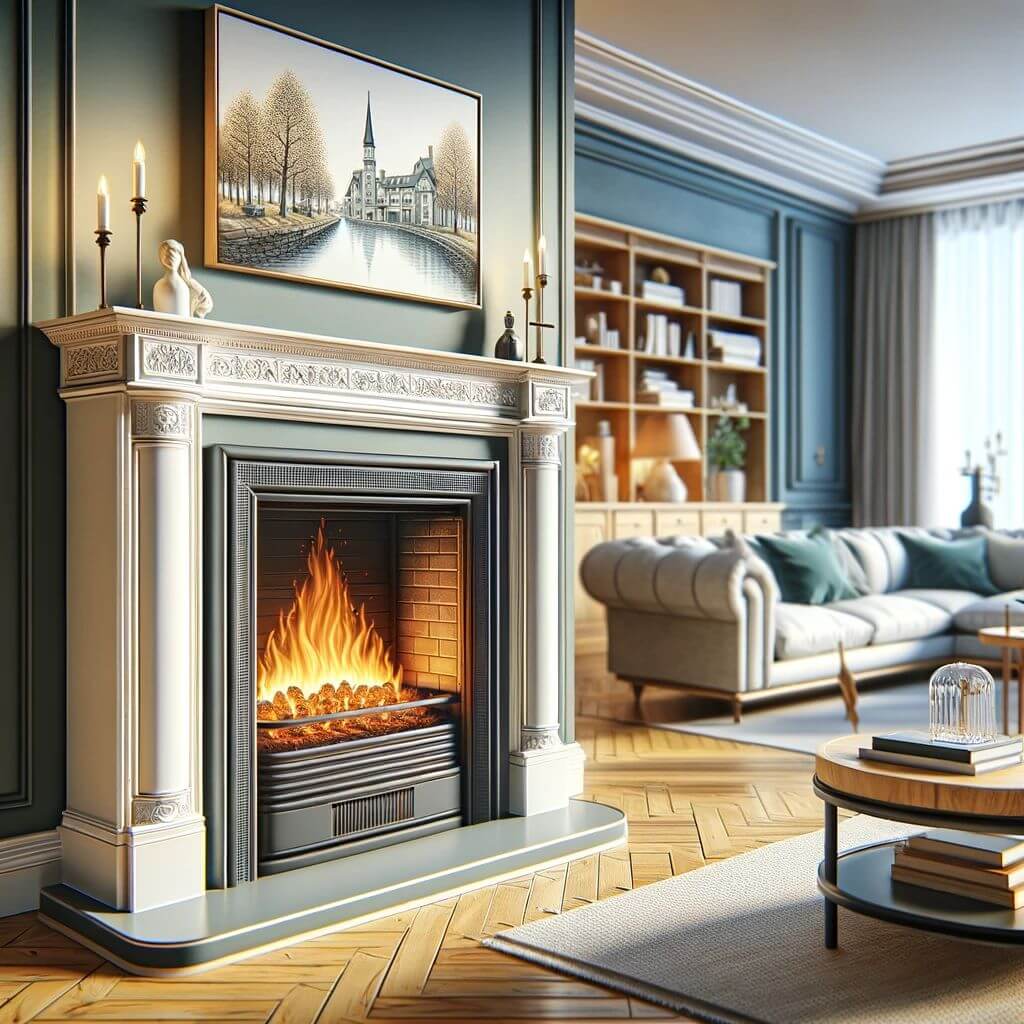The allure of a cozy, flickering fireplace in one’s home has always been irresistible, and in recent years, gas fireplaces have surged in popularity. This surge is attributable to their convenience, efficiency, and the aesthetic appeal they add to modern homes. Unlike the traditional wood-burning fireplaces, gas fireplaces offer a cleaner, more sustainable way of enjoying a warm, inviting flame without the hassle of firewood and ash cleanup.

The purpose of this article is twofold. First, we will explore a crucial question for homeowners and builders: “Does a Gas Fireplace Need a Chimney?” This query is particularly pertinent given the diverse architectural styles and space considerations in contemporary housing.
Second, we dive into the comparison of the two main types of gas fireplaces: ventless and vented. Understanding these distinctions is vital for anyone considering the installation of a gas fireplace, as it impacts not only the design and functionality of the fireplace but also the safety and regulatory compliance of the home.
Basic Understanding of Gas Fireplaces
Gas fireplaces represent a modern and convenient alternative to traditional wood-burning fireplaces, offering a blend of aesthetic appeal and functionality that aligns seamlessly with contemporary lifestyles.
What are Gas Fireplaces?
Gas fireplaces, as the name implies, use natural gas or propane as their fuel source. Unlike wood-burning fireplaces that require logs and constant tending, gas fireplaces ignite with the flip of a switch or the push of a button, offering instant warmth and ambiance.
They eliminate the need for storing wood, extensive cleaning, and dealing with ash and smoke, making them a cleaner and more user-friendly option.
How Do They Differ from Traditional Wood-Burning Fireplaces?

The primary distinction between gas and traditional wood-burning fireplaces lies in their operation and maintenance. Gas fireplaces provide consistent heating without the labor-intensive process of lighting and maintaining a wood fire.
They also produce fewer emissions, making them a more environmentally friendly choice. Additionally, gas fireplaces can be more energy-efficient, converting a higher percentage of their fuel into heat for your home.
Introducing Ventless and Vented Gas Fireplaces
Gas fireplaces are broadly categorized into two types based on their venting requirements:
Ventless Gas Fireplaces
These fireplaces, also known as vent-free or unvented, do not require an external venting system. They are designed to burn gas cleanly and efficiently, releasing very minimal combustion byproducts into the room. Ventless gas fireplaces are lauded for their high efficiency and ease of installation, especially in places where venting to the outside is impractical.
Vented Gas Fireplaces
Vented gas fireplaces expel combustion byproducts outside the home via a chimney or an external vent. They can either use existing chimney structures (with proper lining) or specially installed vents that go directly through an exterior wall. Vented models offer a more traditional fireplace experience, complete with the authentic sound and ambiance of a burning flame, while safely removing exhaust gases.
Chimney Requirements for Gas Fireplaces
Venting is a critical aspect of any fireplace system, as it ensures the safe removal of combustion byproducts. In gas fireplaces, the concept of venting and the requirements for a chimney vary based on the design and type of the fireplace.
The Concept of Venting in Gas Fireplaces
Venting in gas fireplaces is all about how the combustion gases are managed. These gases need to be safely expelled from the fireplace to ensure that the indoor air quality remains safe and the risk of harmful gas buildups, like carbon monoxide, is mitigated. The method of venting is one of the key differentiators between various types of gas fireplaces.
Why Some Gas Fireplaces Need a Chimney
Vented gas fireplaces require an external venting system to expel combustion byproducts outside the home. This is where traditional chimneys come into play. If a home already has a chimney, it can often be used for venting a gas fireplace, provided it’s properly lined and meets current safety standards.
For homes without an existing chimney, direct venting systems can be installed. These systems vent directly through an exterior wall, ensuring safe removal of exhaust gases. The necessity of a chimney or external venting in vented gas fireplaces is primarily due to the volume and nature of the combustion gases they produce.
Gas Fireplaces Without Chimney Requirements:
Ventless gas fireplaces, on the other hand, do not require a chimney or external venting. This is because they are designed to burn gas very efficiently, producing minimal combustion byproducts. These models are equipped with oxygen depletion sensors and other safety features to monitor air quality and gas combustion.
The absence of a venting requirement makes ventless fireplaces a versatile option for many homes, especially where installing a chimney or vent is not feasible. However, it’s important to note that while ventless fireplaces are efficient and convenient, they are not allowed in some areas due to concerns about indoor air quality and safety.
Therefore, the need for a chimney in gas fireplaces depends on the type of fireplace chosen. Vented models require a chimney or an external venting system, while ventless models do not. Understanding these requirements is crucial for homeowners considering a gas fireplace, as it impacts installation, operation, and safety standards.
Vented Gas Fireplaces

Vented gas fireplaces are popular for their ability to combine the convenience of gas with the traditional aesthetics of a classic fireplace. Understanding their functionality, venting requirements, and installation is key for homeowners.
How Vented Gas Fireplaces Work:
Vented gas fireplaces operate by burning natural gas or propane, producing a flame that closely resembles that of a wood-burning fireplace. The key characteristic of a vented gas fireplace is its need to expel combustion byproducts outside the home. This is done through a venting system that either utilizes an existing chimney or a specially designed direct vent.
External Venting Requirement
The external venting is crucial in removing potentially harmful gases, like carbon monoxide, and moisture produced during combustion. This is why vented gas fireplaces are equipped with a flue that directs these combustion byproducts outside, ensuring that the indoor air quality remains safe and comfortable.
Traditional Chimneys vs. Direct Venting
Traditional Chimneys:
For homes with existing chimneys, vented gas fireplaces can often be retrofitted into these structures. This process typically involves installing a flue liner to ensure the chimney is properly sealed and efficient for the new fireplace. The use of existing chimneys is an attractive option for many, as it adds to the traditional charm and aesthetic of the home.
Direct Venting
In contrast, direct vent gas fireplaces do not require a traditional chimney. Instead, they use a dual vent system that can be installed to go directly through an exterior wall. One pipe draws air in for combustion, while the other expels the exhaust. Direct vent fireplaces are highly efficient as they provide a closed combustion system, reducing heat loss and improving safety.
Safety Aspects and Installation Processes
Safety is a paramount consideration in vented gas fireplaces. The proper installation of venting systems ensures the safe removal of hazardous gases. It’s crucial that installation is conducted by certified professionals who can ensure compliance with local building codes and safety standards. Regular maintenance and inspections are also essential to maintain the safe operation of these fireplaces.
Efficiency of Vented Models
While vented gas fireplaces are not as efficient as their ventless counterparts due to some heat loss through the vent, they still offer significant efficiency compared to traditional wood-burning fireplaces. Many modern vented gas fireplaces come with additional features like blowers and heat exchangers to improve heat distribution and overall efficiency.
Ventless Gas Fireplaces

Ventless gas fireplaces, also known as unvented or vent-free fireplaces, offer a unique alternative in the realm of gas heating systems. These fireplaces operate without the need for a chimney or external venting, making them a flexible option for many homeowners.
Operation of Ventless Gas Fireplaces
Ventless gas fireplaces burn natural gas or propane so efficiently that they produce very minimal combustion byproducts, negating the need for a traditional venting system. Instead of expelling exhaust outside, these fireplaces are designed to operate at a level where the combustion byproducts can safely mix with the indoor air without reaching harmful levels.
Technology Behind Safe Indoor Use
The safety of ventless fireplaces hinges on advanced technology and features:
- Oxygen Depletion Sensors (ODS): Ventless gas fireplaces are equipped with ODS, which automatically shut off the fireplace if the oxygen levels in the room fall below a certain threshold.
- Precision Burners: These burners are designed to achieve nearly complete combustion, significantly reducing harmful emissions like carbon monoxide.
- Thermal Efficiency: Ventless models are known for their high thermal efficiency since no heat is lost through venting.
Safety Concerns and Room Size Considerations
While ventless fireplaces are engineered for safety, there are important considerations:
- Room Size: These fireplaces are generally recommended for larger rooms with adequate ventilation to ensure a proper mix of air and combustion gases.
- Humidity and Byproducts: Ventless units release moisture and combustion byproducts into the indoor air. Therefore, it’s important to monitor air quality and humidity levels to prevent issues like mold growth and poor air quality.
Legality and Regulations
The legality of ventless gas fireplaces varies significantly by region and even by city. Some areas have banned them due to concerns over indoor air quality, while others have specific regulations regarding their installation and use. Before purchasing a ventless gas fireplace, it’s crucial to check local codes and regulations.
To recap, ventless gas fireplaces present a viable and efficient heating option for many homes. However, understanding their operation, the technology that ensures their safety, and the legal landscape governing their use is essential for anyone considering this type of fireplace.
Comparing Ventless and Vented Gas Fireplaces

When choosing a gas fireplace, homeowners are often faced with deciding between ventless and vented models. Understanding the key differences between these two types can significantly influence the decision based on individual needs and preferences.
Installation Flexibility and Requirements
- Ventless Fireplaces:
- Flexibility: Ventless units offer greater flexibility in installation since they do not require a chimney or external venting. This makes them ideal for homes where venting is not possible or where space is limited.
- Requirements: Installation typically involves fewer structural alterations, making them less invasive and often more cost-effective to install.
- Vented Fireplaces:
- Flexibility: Vented models are less flexible in terms of installation locations. They require access to an external wall for direct venting or a pre-existing chimney.
- Requirements: If using an existing chimney, it may need modifications or a new lining, which can add to the installation complexity and cost.
Energy Efficiency and Heating Capacity
- Ventless Fireplaces:
- Known for high energy efficiency, ventless fireplaces convert nearly all the fuel into heat.
- They provide a substantial amount of heat, making them effective for heating larger spaces.
- Vented Fireplaces:
- These models tend to lose some heat through the venting process, making them slightly less efficient than their ventless counterparts.
- However, they still provide sufficient heating capacity and are more suitable for continuous, long-term use.
Safety Features and Considerations
- Ventless Fireplaces:
- Equipped with safety features like oxygen depletion sensors.
- Concerns over indoor air quality and humidity levels persist, necessitating adequate room ventilation.
- Vented Fireplaces:
- The external venting significantly reduces the risk of indoor air quality issues.
- They are often preferred for their safety profile, especially in homes with children, elderly, or those with respiratory issues.
Maintenance and Operational Costs
- Ventless Fireplaces:
- Lower operational costs due to higher efficiency.
- Maintenance is relatively straightforward, involving regular inspections and keeping the unit clean.
- Vented Fireplaces:
- May incur higher operational costs due to some heat loss.
- Maintenance includes keeping the venting system clean and functional, which can sometimes necessitate professional service.
It is important to note that both ventless and vented gas fireplaces have their advantages and limitations. The choice largely depends on individual requirements regarding installation, efficiency, safety, and ongoing maintenance. Understanding these aspects can help homeowners make a well-informed decision that aligns with their specific needs and home environments.
Making the Right Choice for Your Home

Choosing between a ventless and vented gas fireplace is a decision that hinges on several individual factors. Here’s a guide to help you navigate through these options, considering your home layout, local regulations, and personal preferences.
Consider Your Home Layout
- Space and Ventilation:
- For homes with limited space or no existing chimney, a ventless fireplace offers an efficient solution without the need for extensive installation work.
- If your home has an existing chimney or can accommodate a direct vent system, a vented fireplace could be more suitable, especially if you prefer the traditional fireplace experience.
Understand Local Regulations
- Building Codes and Safety Standards:
- Before making a decision, it’s crucial to check your local building codes and safety standards. Some regions have specific regulations regarding the installation of ventless fireplaces due to concerns about indoor air quality.
- Understanding these regulations can prevent legal issues and ensure that your fireplace installation is compliant and safe.
Personal Preferences and Lifestyle
- Aesthetics and Ambiance:
- Consider the aesthetic you wish to achieve. Vented fireplaces often offer a more traditional look and feel, complete with the sound of burning gas, which many find appealing.
- Ventless fireplaces have a more modern appeal and can fit seamlessly into contemporary home designs.
- Usage and Heating Needs:
- If your primary goal is efficient heating, a ventless fireplace might be the better choice due to its higher efficiency and heat output.
- For those who value the experience and ambiance of a traditional fireplace, and who use the fireplace more for aesthetic purposes, a vented model might be more appropriate.
Budget and Long-Term Costs
- Installation and Operational Costs:
- Ventless fireplaces generally have lower installation and operational costs but may have limitations in terms of usage duration and room size.
- Vented fireplaces, while potentially more costly to install, especially if structural modifications are needed, offer a more traditional experience and are less restrictive in terms of continuous usage.
Thus, the choice between a ventless and vented gas fireplace depends on a balance of practical considerations and personal preferences. Assessing your home’s layout, understanding local regulations, and considering your lifestyle and aesthetic preferences will guide you in making a choice that best fits your needs and enhances the comfort and ambiance of your home.
Conclusion
In this comprehensive exploration of gas fireplaces, we’ve delved into the critical aspects of both ventless and vented models. The choice between these two types of fireplaces hinges on various factors including installation requirements, energy efficiency, safety considerations, and personal preferences.
- Vented fireplaces, while requiring a chimney or external venting, offer the traditional fireplace experience with a higher degree of safety regarding indoor air quality. They are suitable for homes with existing chimneys or the ability to install direct vents.
- Ventless fireplaces stand out for their high energy efficiency and flexibility in installation. However, they come with considerations regarding indoor air quality and are subject to specific regional regulations.
Understanding the specific requirements and features of each type is crucial in making an informed decision that aligns with your home’s layout, local building codes, and your personal needs.
FAQs
Q: Can I install a ventless gas fireplace in any room? A: While ventless fireplaces offer flexibility in installation, they are best suited for larger rooms with good ventilation. It’s also essential to adhere to local regulations, as some areas restrict their use.
Q: Do vented gas fireplaces always require a traditional chimney? A: No, vented gas fireplaces can either use an existing chimney with a proper lining or a direct vent system that expels gases through an exterior wall.
Q: Are ventless gas fireplaces safe? A: Yes, when used according to manufacturer guidelines and local codes. Ventless fireplaces are equipped with safety features like oxygen depletion sensors. However, they should be used in well-ventilated areas.
Q: How often should I have my gas fireplace serviced? A: It’s recommended to have your gas fireplace inspected and serviced annually by a qualified technician to ensure safe and efficient operation.
Q: Is there a significant difference in the heating capacity between ventless and vented gas fireplaces? A: Yes, ventless gas fireplaces are generally more efficient in heating since they don’t lose heat through a vent or chimney. However, vented models provide a more traditional heating experience.

Leave a Reply